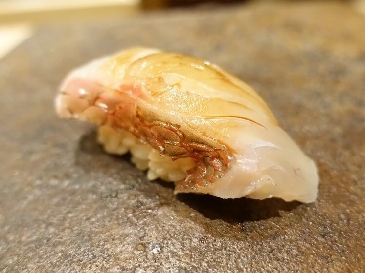White flesh


Red seabream (Tai)
【Nigiri sushi: Shiromi】
Fish such as Seabass, Red snapper, Cod, Flounder, and Fluke Flatfish are referred to as Shiromi (Shiro means white and mi means flesh) in sushi restaurant jargon. The name comes from the fact that the flesh of the fish is white. In sushi restaurants, they are actually all high-end items.
There are about 3,900 known fish species in Japan, and of those 360 have a Japanese name ending in “-tai/dai”. However, only 13 of those belong to the most major “tai” family. Some of those are madai, chidai, kidai, and kurodai. The most familiar fish named like this, such as Ishidai, Kinmedai, and Ebodai, actually has nothing to do with the tai family.
Thanks to its refined appearance, Red seabream (Madai) has been considered an auspicious fish in Japan from olden times. It is known for its savory flavor, firm texture, and very tasty flesh and is considered to be the king of white fish. There are two ways to enjoy Madai, either served skinless to enjoy the concentrated sweet flavor of the white flesh or as Matsukawa-zukuri, parboiled with the skin. The customer has an opportunity to savor the flavor of the entire fish, the skin, the fat under the skin, and the white flesh. Sea bream is served between winter and spring, the spawning period. There is one red seabream that recurrently migrates on the coast of the Seto Inland Sea for spawning, called Sakuradai (cherry blossom sea bream), which is especially delicious and highly valued. Meanwhile, once the spawning is complete and the fish loses its flavor, it’s called Mugiwaradai (barley straw seabream).
Also called Red snapper or Snapper Sea bream or Genuine porgy or Porgy.
Main production area
Setonaikai Nagasaki Kumamoto Kagoshima
Season
Winter-Early spring

